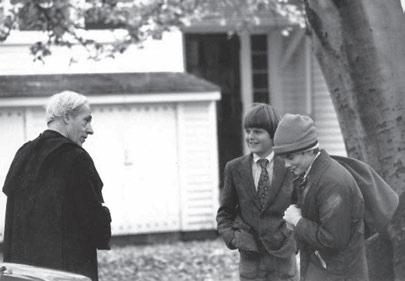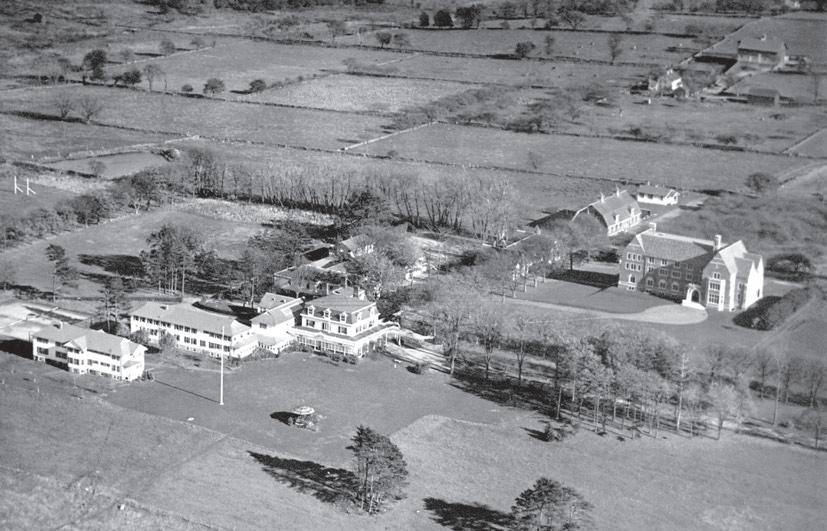
13 minute read
Education in the Face of Adversity
by Vincent Scanlan ’79
When the novel corona virus spread across the globe in the spring of 2020, leaders around the world were quickly predicting the pandemic would be the most disruptive world event since World War II. Throughout its 95-year history Portsmouth has faced many external events that have challenged the operation of the school. For many in the current Portsmouth community, it is hard to imagine a more significant event that has touched almost every aspect of their educational experience than COVID-19. These include such inconveniences as virtual classrooms, quarantine, sports cancellations, temperature checks, travel disruptions, and countless numbers of pandemic protocols. To put this all of the recent events into perspective, I recently sat down with my father, Joe Scanlan ’46, to help compare the challenges faced by Portsmouth today compared with those of the 1940s that had a world war raging in the background while Portsmouth tried to maintain a semblance of normalcy for a small group of high school boys pursuing a secondary school education. As a former student and parent to five Portsmouth students (Thomas ’77, Vincent ’79, Brian ’80, Michael ’82, Daniel ’89), Joe was able to provide a unique viewpoint of the school through a lens that goes back nearly eighty years.
In the fall of 1942 Joe was a 14-year-old boy living in Danbury, Connecticut, preparing to enter high school. Joe was the youngest of four children being raised by his mother, having lost his father twelve years earlier. Joe’s mother maintained the educational philosophy that high school should be a two-part experience. The first two years of high school were to be spent in the public schools developing a network within the town.
The second two years were to be spent in a private secondary school preparing for college admissions. During the time that Joe spent at Danbury High School, the United States was unwillingly pulled into in World War II following the bombing of Pearl Harbor in December 1941. Joe enjoyed the time he spent at Danbury High School, but by the end of his sophomore year in the Spring of 1944 he was very much looking forward to attending an up-and-coming boarding school in Rhode Island that he knew little about except that Portsmouth Priory had come highly recommended to his mother by many friends and family. Joe spent much of the summer of 1944 preparing for his entry into the Priory that fall. The summer was filled with many positive developments on the war front that gave many in the United States room for optimism that the long war might be nearing an end. The most notable event was the Allied invasion of France in June of 1944 that would lead to the liberation of Paris by the end of summer. Unfortunately the hopes for the end of the war were dashed by the expansion of war activities in the Pacific theater.
When Joe arrived in Portsmouth after Labor Day, Rhode Island was dealing with another challenge: The Great Atlantic Hurricane of 1944. Joe was welcomed on campus with the extensive rain and wind damage left behind by an historic Category 4 Hurricane. The ninety-five mile per hour winds that whipped off of Narragansett Bay uprooted trees and damaged many buildings in its path. Damages to Aquidneck Island were estimated at $500,000. The storm left much recovery work for the new incoming students to undertake. Joe recalls the student work squads that were assigned cleanup tasks from the storm. One of Joe’s cleanup assignments was the boathouse, which
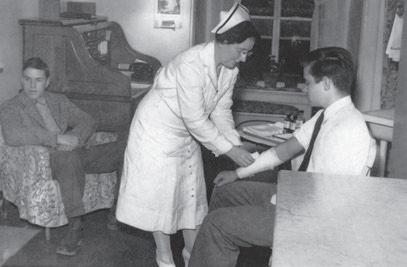

sustained extensive damage to the building and boats. It was this experience that began Joe’s love affair with boats, including his eventual service with the U.S. Navy after college. The mandatory work squads of 1944 represented the last year of their existence as they were replaced by calisthenics (for those lesser-skilled athletes) the following year by the incoming athletic director. Despite many challenges, the Priory achieved a significant enrollment goal that fall. Headmaster Father Gregory Borgstedt worked steadfastly to attain Priory enrollment of 119 in the fall of 1944, despite the fact that the school had decided to eliminate the First Form. In fact, the school found itself with so many applications that it was
forced to limit the number of applications that it could accept. Between the Priory and St. George’s, down the way in Newport, both schools found a way to achieve their enrollment goals while the world war carried on in the background. This was the year that the rivalry between the Priory and St. George’s was in its infancy and began to emerge into the great rivalry that it is today. Tuition at the Priory for students that fall was $1,400 per student. The decision to send their sons to Portsmouth required many families to make the difficult decision between educating their sons and the other priorities competing with the ongoing war. While the enhanced enrollment was very much an asset for the school, finding enough housing for the new incoming students would present significant challenges for the administration. The challenges went beyond just building additional housing for the students. Since the war effort was the critical priority for the government, many of the critical supplies needed to build student housing were controlled by the U.S. War Production Board, which provided oversight in rationing the building supplies and many other critical materials. Portsmouth had the goal of completing renovations for The Barn for the incoming Fifth Formers in 1944. While the school was able to secure enough basic materials for The Barn renovations, it was very sparse accommodations by today’s standards. One of the most critical shortages was the iron used for making the radiators for heating. When the initial renovations to The Barn were completed for the fall of 1944, heating was only provided in the common areas and bathrooms on the second floor. The incoming students were instructed to bring extra blankets and warm pajamas since heating was very limited in the actual dorm rooms. The winter of 1945 was a cold one and the shortage of heat in The Barn took its toll on one student who came down with pneumonia. Housemaster Brother Aelred quickly shared his concerns with the headmaster about the dire living conditions. Shortly after that the War Production Board saw to it to allocate the necessary radiators to provide heat to the individual rooms in The Barn. Student dining was also impacted during Joe’s first year. The food menu selections were very sparse, with limited amount of meat offerings. Amenities like butter, sugar, and bacon were rarely included with any meals, and always considered a luxury when available. Joe still recalls “after hour visits” to the Manor House kitchen to obtain those provisions that were always in short supply during regular dining hours.
Mr. and Mrs. Springer with the boys of St. Benet’s, 1942
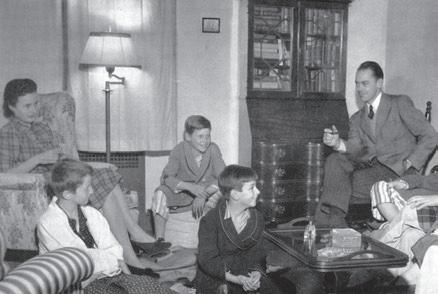
Father Ansgar at Portsmouth Priory, later appointed Bishop of Sweden by Pope Pius XII
The Old Barn. After demolition the cupolas were restored and now adorn the roof of the McGuire Art Building.
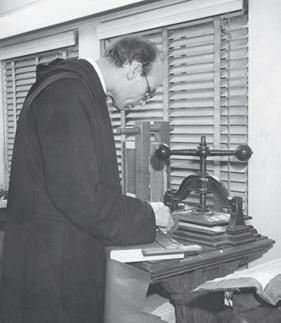
Life in the Barn was not without its share of high school boy antics either. Joe recalls the story of a displaced French citizen who had found his way to Portsmouth from France to escape the war. The young man was serving as the assistant housemaster in the Barn that year in addition to teaching French. This generous young man took it upon himself to gather unused clothing from the Fifth Formers so that he could ship them to needy families in France. One boy (who will forever remain nameless), told the young Frenchman about a “fur-lined undergarment” that Brother Aelred had and was willing to donate. When the unknowing humanitarian approached Brother Aelred about making a donation, laughter could be heard throughout The Barn amongst its residents. Joe noted that even during the tough days of the war, the students always found a way to laugh.
The beginning of Joe’s Sixth Form in the fall of 1945 was filled with optimism on many fronts. While Joe had spent the summer at home in Connecticut, significant events on the war front made the end of the war seem inevitable. When Joe returned to campus in September there was much talk about “the new kind of bomb” that the Americans had used in Japan to force surrender. The bombing of Hiroshima and Nagasaki in August and the signing of the Instrument of Surrender in September finally brought a formal conclusion to the long war. After four years of American involvement in the war there was an amazing amount of positive energy present on the Priory campus. Joe admitted how naive the students were in understanding the future implications of using atomic weapons and the impact on future wars. While everyone expected things to return to normal quickly, shortages of critical items like sugar, meat, and gas remained in scarce supply for the remainder of the school year.
As a senior Joe was assigned to The Red dorm. The Red was built in 1928 and was one of the four residences used for students. Danish exile Father Ansgar was the housemaster. Joe took an immediate liking to Father Ansgar who had travelled the world and was always willing to engage with the students in his dorm. Joe’s memories of life in The Red are still quite vivid. Joe recalls spending many nights talking with Father Ansgar about growing up with socialism in Denmark, his conversion to Catholicism from being Lutheran, and his coming to America and becoming a Benedictine monk. Father Ansgar provided Joe a perspective that was unique and was quite refreshing during the challenging war years. Interestingly enough, Father Ansgar was appointed by Pope Pius to be the Bishop of Sweden shortly after Joe graduated Portsmouth.
In December of 1945 the Dramatics Club continued to make its postwar comeback

Dom Hilary Martin with his beloved sheepdog, Lad, 1942
after being challenged by resource limitations from the war. While Joe never considered himself an actor, he very much enjoyed being part of the stage crew that produced a one night showing of three one-act plays. Joe recalls learning an appreciation for Irish drama with the production of “The Doctor from Dunmore.” This was also Joe’s first time working with Assistant Headmaster Dr. Brady, whom he found to be one of the more caring and compassionate faculty members during his Portsmouth experience.
By the winter of 1946 Joe sensed an amazing level of energy and optimism in all aspects of the Portsmouth community, especially within the monastic community. While there were several monks forced into retirement due to failing health, there was also a significant number of young men who committed to the Priory and others who would be ordained by the end of the school year. It was through this level of enthusiasm within the community that served as the impetus for major fund-raising activities and facility improvement and expansion over the next two years.
While there was never a pandemic during Joe’s time at Portsmouth, he did recall a similar memory that occurred in April of 1946. Right after the St. George’s boys returned to Newport after the Easter break (many of them from New York), there was a mild outbreak of measles and chicken pox on the St. George’s campus. After the visiting Priory baseball team defeated St. George’s 4-3 with a ninth-inning rally, the team was quickly taken back to Portsmouth. The usual post game tea and refreshments were abruptly suspended. Apparently the St. George’s headmaster had mandated that all students self-isolate to mitigate the risk of any potential spread. During this brief time all the Priory boys were prohibited from going to movies and other public places in Newport. The short-term “lockdown” ended quickly in May with the resumption of the normal spring activities.
The final month at Portsmouth was a memorable one for Joe and his fellow Sixth Formers. On the second Saturday night in June, the five-year Prom tradition continued at the Manor House. While seeing girls on campus was always a rare sight back then, welcoming twenty-seven girls to the Priory dance was an especially refreshing change that year. Memories of the music and dancing from The Ed Drew Orchestra for the gala event still bring a smile to Joe’s face. The following Monday, the Athletic Awards dinner was held to recognize the spring athletes, including Joe’s good friend Mike Corcoran, a Newport boy who was the standout Raven center fielder and

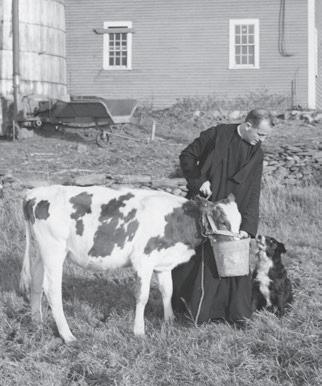
A wecome social visit from the girls of Elmhurst School, 1943
Three decades later, Dom Andrew Jenks stops on campus to chat with Joe’s son, Vince’s brother, Thomas Scanlan’77 (right) and Anthony Bessenger ’77.
team captain. When graduation finally arrived on Tuesday the Sixth Formers were more than ready for prize day. Only one of the 15 graduates had endured the fourwar year experience at Portsmouth. While most of Joe’s classmates arrived in the fall of 1944, all of his classmates shared a unique bond as a result of the trials and tribulations that the war year experiences had brought them.
Commencement Day 1946 was an unforgettable day for the graduating seniors. Joe noted that there was added excitement to the ceremony that year since it marked the twentieth anniversary of the first eighteen students enrolling at Portsmouth in 1926. That Tuesday morning was a typical cloudy overcast Rhode Island day that began with a solemn high Mass celebrated by Father Gregory Borsteadt at six-thirty in the morning. A tent was set up for parents and guests on St. Benet’s lawn (where St. Mary’s sits today). The honored guests at the commencement included Priory founder and headmaster emeritus Father Hugh Diman. The keynote speaker was longtime Priory benefactor Basil Harris, Chairman of the Board of United States Lines, the country’s largest passenger-freight steamship carrier. It was through Mr. Harris’ generous gift of $100,000 to Portsmouth in 1930 that the construction of St. Benet’s House became possible. Joe recalls a message from Mr. Harris that focused on the importance of supporting the advocacy for Catholic private school education.
The following fall Joe went on to enroll at Georgetown University and graduated four years later. While the experiences that Joe took with him from Portsmouth may be unique to the graduates that followed him, he felt that the resilient and positive approach that he took with the challenges that he faced could benefit any student facing similar obstacles in the future. When asked about being a part of what is now known as the “greatest generation,” Joe will humbly state that everyone is part of the greatest generation. As Joe reflects on his upcoming seventy-fifth anniversary reunion this year he remains grateful for the experiences he shared during his time at Portsmouth during extraordinary times. When I asked Joe what he is most grateful for from his Portsmouth experience, he proudly tells me that having five sons and one grandson who got to share the same educational experience still provides him a great sense of happiness. His wife, Robin, went on to become the Portsmouth librarian who was instrumental in transitioning an outdated library into the current modern-day library up until her retirement in 1999. Joe and Robin have lived across the bay in Bristol since 1964 and still visit Portsmouth whenever possible.
d
Vince Scanlan graduated from Portsmouth Abbey in 1979 and from Syracuse University with a B.A. in International Relations in 1983. Vince spent the majority of his professional career in consumer banking overseeing regulatory compliance activities for both large and midsized banks. Currently Vince consults with private equity businesses looking to provide banking products and services outside of the traditional banking environment. Additionally, Vince works as a freelance photographer creating both landscape and portrait images for the community in Bucks County Pennsylvania. His current projects include writing an historical perspective of his Irish American ancestry dating back to the early nineteenth century. Vince lives in Newtown, Pennsylvania, with his wife, Jacqueline, and son, Aidan.
